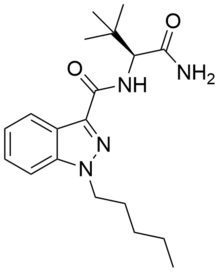ADB-PINACA
From Wikipedia, the free encyclopedia
 |
|
| Legal status | |
|---|---|
| Legal status |
|
| Identifiers | |
|
|
| CAS Number | 1633766-73-0 |
| PubChem (CID) | 86280478 |
| ChemSpider | 29342129 |
| Chemical and physical data | |
| Formula | C19H28N4O2 |
| Molar mass | 344.51 g/mol |
| 3D model (Jmol) | Interactive image |
|
|
|
|
ADB-PINACA is a cannabinoid designer drug that is an ingredient in some synthetic cannabis products. It is a potent agonist of the CB1 receptor and CB2 receptor with EC50 values of 0.52 nM and 0.88 nM respectively.[1][2] Like MDMB-FUBINACA, this compound contains an amino acid residue of tert-leucine.
Contents
Side effects[edit]
ADB-PINACA has been linked to multiple hospitalizations and deaths due to its use.[3][4][5]
Legality[edit]
ADB-PINACA is listed in the Fifth Schedule of the Misuse of Drugs Act (MDA) and therefore illegal in Singapore as of May 2015.[6]
In the United States, it is a Schedule I controlled substance.[7]
As of October 2015 ADB-PINACA is a controlled substance in China.[8]
See also[edit]
References[edit]
- ^ Samuel D Banister; Michael Moir; Jordyn Stuart; Richard C Kevin; Katie E Wood; Mitchell Longworth; Shane M Wilkinson; Corinne Beinat; Alxendra S Buchanan; Michelle Glass; Mark Connor; Iain S McGregor; Michael Kassiou (July 2015). "The pharmacology of indole and indazole synthetic cannabinoid designer drugs AB-FUBINACA, ADB-FUBINACA, AB-PINACA, ADB-PINACA, 5F-AB-PINACA, 5F-ADB-PINACA, ADBICA and 5F-ADBICA". ACS Chemical Neuroscience. 6: 1546–59. doi:10.1021/acschemneuro.5b00112. PMID 26134475.
- ^ "ADB-PINACA". Forendex.
- ^ "CDC: 221 sickened by synthetic pot in Colorado". USA Today. December 12, 2013.
- ^ Michael D. Schwartz; et al. (March 2015). "A Common Source Outbreak of Severe Delirium Associated with Exposure to the Novel Synthetic Cannabinoid ADB-PINACA". Journal of Emergency Medicine. 48 (5): 573–580. doi:10.1016/j.jemermed.2014.12.038. PMID 25726258.
- ^ Jordan Trecki; Roy R. Gerona; Michael D. Schwartz (July 2015). "Synthetic Cannabinoid–Related Illnesses and Deaths". New England Journal of Medicine. 373 (2): 103–107. doi:10.1056/NEJMp1505328. PMID 26154784.
- ^ "CNB NEWS RELEASE". Central Narcotics Bureau (CNB). 30 April 2015. Retrieved 24 July 2015.
- ^ "Schedules of controlled substances: temporary placement of four synthetic cannabinoids into Schedule I. Final order". Fed Regist. 79 (27): 7577–7582. Feb 10, 2014. PMID 24605391.
- ^ "关于印发《非药用类麻醉药品和精神药品列管办法》的通知" (in Chinese). China Food and Drug Administration. 27 September 2015. Retrieved 1 October 2015.